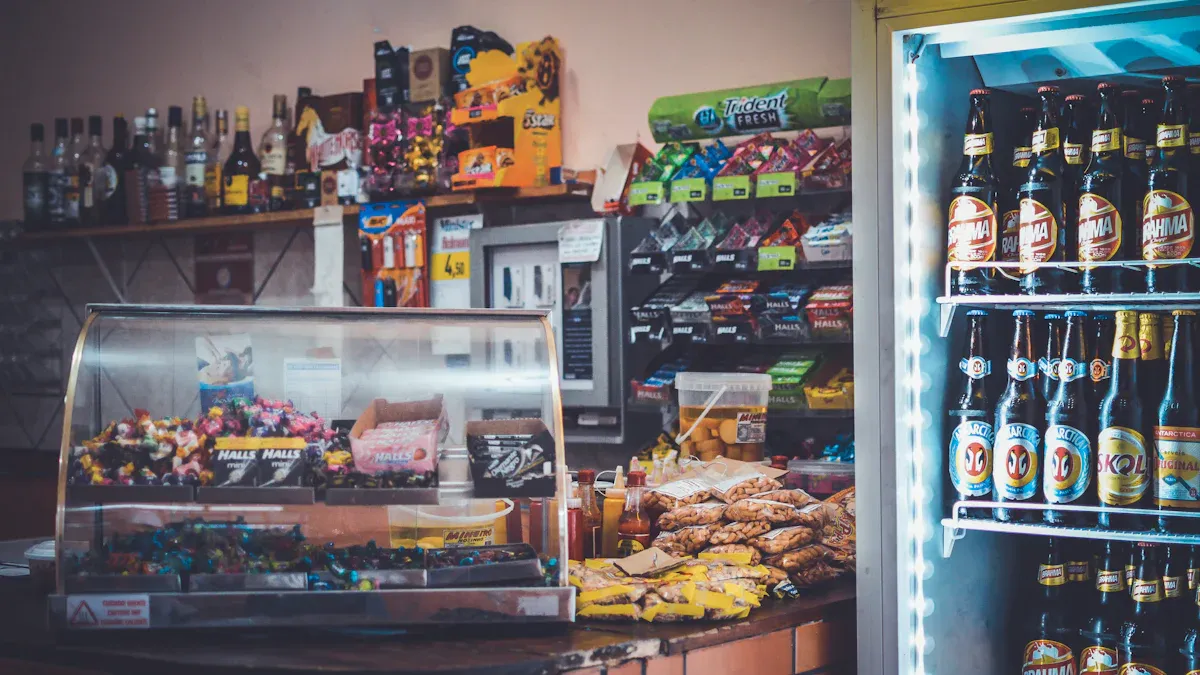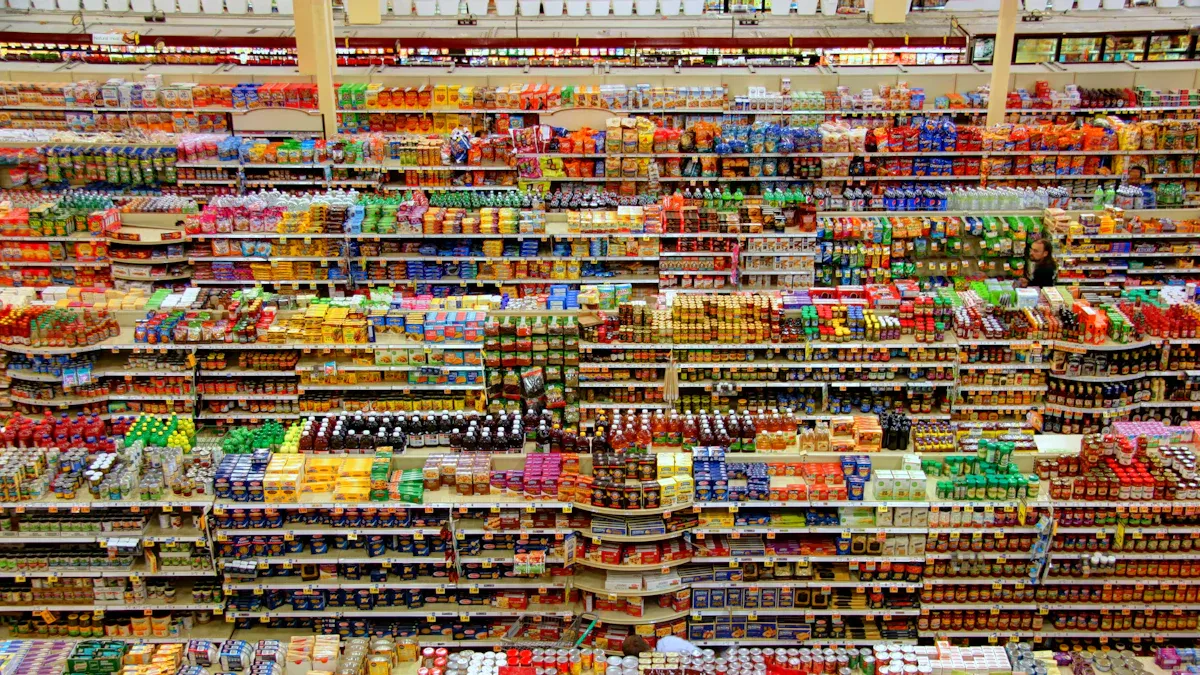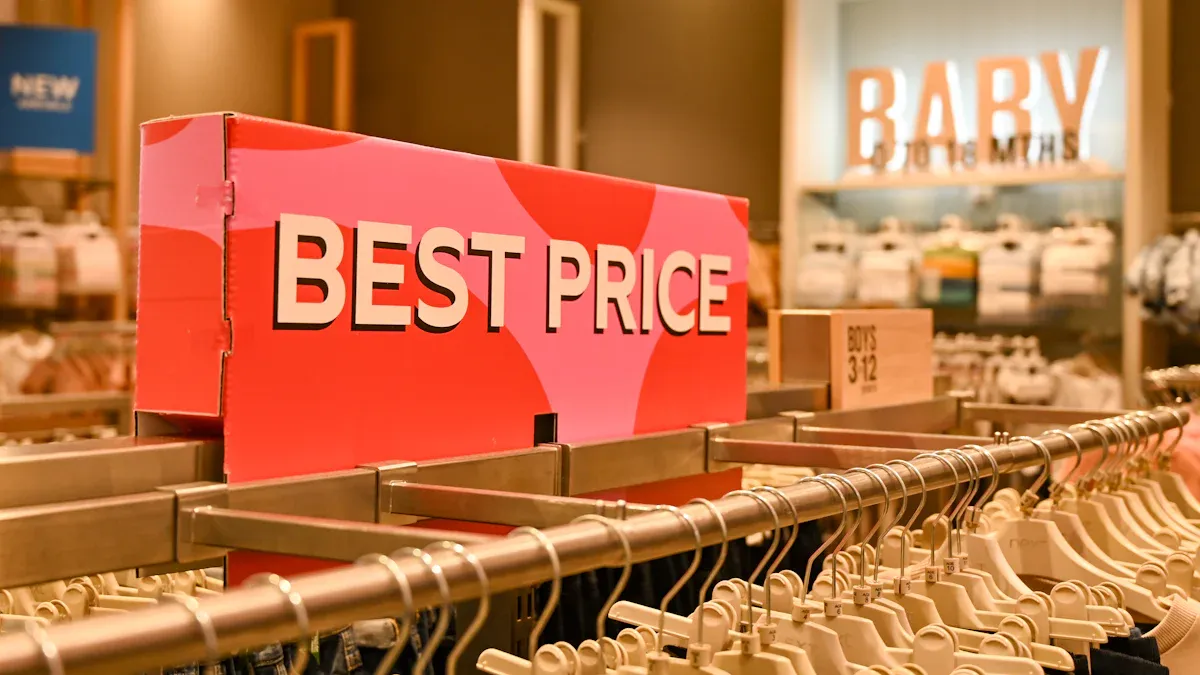
Display racks are pivotal in influencing unplanned purchases. Strategic display design directly impacts consumer behavior and sales. Optimizing store display racks can boost customer engagement by up to 30%. Effective product placement strategies can increase sales by 15%. These improvements directly contribute to increased impulse buying. Products placed on end caps can experience approximately 20% more sales, highlighting the power of strategic positioning. Utilizing data-driven approaches for display optimization can lead to a 10-15% sales increase.
Key Takeaways
- Display racks help people buy things they did not plan to buy.
- There are different types of impulse buys, like buying something because you remembered you needed it or because it looked good.
- Feelings, wanting things right away, and thinking something is a good deal make people buy on impulse.
- Good displays make products look nice and easy to reach, which helps people buy them.
- Placing display racks in busy areas, like near the store entrance or checkout, makes more people see and buy items.
- Using bright colors and good lighting on displays makes products stand out and feel exciting.
- Letting customers touch products and using screens they can interact with helps them decide to buy.
- Retailers check sales numbers and watch customers to see if their displays are working well.
The Science of Impulse Buying
Retailers often observe customers making unplanned purchases. Understanding the underlying science behind these decisions helps optimize display strategies. Psychologists and marketers have extensively studied the mechanisms driving spontaneous consumer behavior.
Understanding Impulse Buying Types
Impulse buying is not a monolithic phenomenon; it manifests in several distinct forms. Each type reflects a different level of consumer intent and psychological trigger.
Pure Impulse Buys
Pure impulse buys occur solely based on a spur-of-the-moment emotion. Consumers have no prior intention to purchase the specific item. Strategic placement of items, such as magazines or small cookies near checkout counters, often triggers these purchases.
Reminder Impulse Buys
Consumers make reminder impulse buys when they see an item and remember they need it. They might have forgotten to add it to their shopping list.
Suggestion Impulse Buys
Suggestion impulse buys happen when a customer sees a product for the first time and visualizes a need for it. The product’s presentation or description suggests a new use or benefit.
Planned Impulse Buys
Planned impulse buys involve an initial intention to buy certain items, but consumers are influenced to buy more than planned. Offers like ‘buy three get one free’ deals often trigger this behavior. Shoppers rationalize buying more by considering future use or existing plans. For example, a customer might intend to buy one bag of chips but then purchases three bags and gets a free soda.
| Characteristic | Pure Impulse Buys | Planned Impulse Buys |
|---|---|---|
| Basis of Purchase | Solely on spur-of-the-moment emotion | Intention to buy certain items, but influenced to buy more than planned |
| Trigger | Strategic placement of items (e.g., magazines, small cookies) | Offers (e.g., ‘buy three get one free’ deals) |
| Shopper’s Thought Process | Buys because the item evokes a feeling | Rationalizes buying more by considering future use or existing plans |
| Initial Intent | No prior intent to purchase the specific item | Prior intent to purchase the base item, but not the increased quantity or associated item |
| Example | Buying a magazine or small cookies at the checkout counter | Buying three bags of chips and getting a free soda when only one bag was initially intended |
Psychological Drivers of Impulse Buying
Several psychological factors contribute to impulse purchases. These drivers often bypass rational decision-making processes.
Emotional Responses
Emotional responses play a significant role in driving unplanned purchases. Positive emotions, such as pleasure, excitement, and satisfaction, often triggered by external stimuli like promotional campaigns, enhance cognitive appraisal. This leads to a strong, fast drive to consume. Heightened arousal can weaken self-control, making individuals more inclined towards intuitive processing and self-reward. Impulse purchases are frequently driven by a sudden, intense emotional desire, resulting in reactive behavior with low cognitive control. The Dual-Process Theory explains this as System 1 thinking, which is fast, automatic, intuitive, and emotionally driven, often bypassing slower, analytical System 2 thinking.
Instant Gratification
The desire for immediate pleasure and satisfaction strongly influences impulse buying. Consumers often seek instant gratification, and an unplanned purchase provides this immediate reward. This tendency to buy spontaneously is explained by the immediate pleasure and satisfaction it provides to the buyer.
Perceived Value
Consumers’ perception of an item’s value significantly impacts their likelihood of making an impulse purchase. Several cognitive biases influence this perception:
- Anchoring Bias: Consumers rely heavily on the first piece of information received, such as an initial price, influencing perceived value.
- Loss Aversion: Consumers prefer avoiding losses over acquiring gains, leading to behaviors driven by fear of missing out (FOMO) or losing a good deal.
- Social Proof: People look to others’ actions for guidance, with positive reviews or testimonials influencing decisions.
- Endowment Effect: Once individuals own something, they tend to overvalue it, impacting pricing perceptions.
The Theory of Planned Behavior suggests that attitude towards buying and perceived behavioral control also shape purchase intentions. Additionally, Maslow’s Hierarchy of Needs posits that impulse purchases can stem from unconscious attempts to satisfy psychological needs like belonging or esteem.
Display Racks and Consumer Perception

Visual Appeal for Impulse Buying
First Impressions
Store displays directly influence how consumers perceive products. Visually appealing and organized displays create a positive initial impression. This makes products seem more desirable and of higher quality. It affects purchasing decisions. Well-designed display racks contribute to these positive impressions. They make products appear more premium and enhance the overall brand experience. Custom displays allow brands to control their narrative. They present their identity, whether premium, fun, or healthy. Creative designs, graphics, and messaging differentiate a brand from competitors. This reinforces brand identity and fosters recognition. Colors also play a crucial role. Warm hues like red, orange, and yellow communicate energy and excitement. These colors encourage impulse buying. Bold rack frames against muted backgrounds make products pop, capitalizing on primal attraction to contrast.
Product Visibility
Maximizing product visibility is essential. Products placed at eye level tend to receive more attention and generate higher sales. End-cap racks, positioned at the ends of aisles, significantly increase the visibility of new or promotional items. Retailers position displays at eye level. They use strategic lighting to highlight key products. Employing bright, contrasting colors judiciously makes the display stand out. Tiered racks revolutionize space efficiency. They transform vertical voids into layered showcases. This boosts product visibility and prevents visual clutter. Strategic lighting spotlights seasonal specials like a stage production, drawing attention to premium items.
Enhancing Product Accessibility
Ease of Reach
Effective displays offer an accessible interface. They help customers locate items quickly. This improves their overall shopping experience. Confused or overwhelmed customers are less likely to make impulse purchases. Clear and well-organized displays contribute to a positive shopping experience. This encourages impulse buying. Displays closer to the main aisle of a product category have a greater positive impact on purchase incidence. Front end cap displays have the largest impact on consumer category purchase incidence.
Encouraging Interaction
Interactive displays engage customers. Rotating units or touch-responsive surfaces lead to longer exploration times. Retailers incorporate interactive elements. These include digital screens, QR codes, tactile materials, or moving parts. Such elements engage customers and create memorable experiences.
Creating Urgency for Impulse Buying
Limited-Time Offers
Limited-time offers leverage the human tendency to desire what will not last forever. Examples include seasonal beverage flavors or new store opening discounts. Real urgency communicates offers with a definite expiration. These include seasonal sales or two-day promotions. Event-based urgency ties promotions to calendar milestones. These can be product launches, holidays, or special events. A countdown timer visually displays the remaining time for an offer or discounted price. This creates a strong sense of immediate action. It works best for limited-edition items.
Scarcity Messaging
Scarcity messaging triggers faster purchase decisions. Rack signage like “Last 3 In Stock!” creates decision urgency. Products available in finite quantities, such as limited-print artwork or exclusive sneakers, increase perceived value. This prompts quicker purchases. “Last Chance Alerts” notify customers that a product is a limited-time offer or low in stock. This encourages immediate purchase. Retailers employ urgent words and phrases. Terms like “last chance,” “limited edition,” “only today,” or “while supplies last” imply rarity and temporariness.
Strategic Placement for Impulse Buying
Strategic placement of display racks significantly influences consumer behavior. Retailers carefully consider store layouts to maximize opportunities for unplanned purchases. Understanding customer flow and product visibility is crucial for effective merchandising.
High-Traffic Zones
High-traffic zones within a retail store offer prime locations for display racks. These areas naturally draw more customer attention, increasing the likelihood of product discovery and purchase.
Decompression Zones
Decompression zones are the first areas customers encounter upon entering a store. These spaces allow shoppers to adjust to the store environment. Retailers often place visually appealing displays here to capture immediate interest. Understanding customer movement patterns, such as shoppers typically turning right and moving counterclockwise, helps arrange display racks effectively in these zones.
Power Walls
Power walls are prominent display areas, often at the end of aisles or along main walkways. They serve as focal points, showcasing new arrivals, promotional items, or bestsellers. Placing high-demand products throughout the store, especially towards the back, increases customer exposure to other merchandise and potential impulse buys. These walls attract attention and encourage further exploration.
Checkout Counter Displays
Checkout counters represent a critical point for capturing last-minute sales. Customers often experience wait times here, making them receptive to small, convenient purchases.
Last-Minute Opportunities
Checkout counter displays create prime visibility for impulse purchases. Their eye-level placement and compact design make them highly effective. High-traffic areas, such as checkout counters, are ideal for strategic placement of smaller items to boost impulse purchases. These displays capitalize on the final moments of a customer’s shopping journey.
Small, High-Margin Items
Products most successfully sold through checkout counter displays are typically small, high-margin, and low-cost impulse items. These items are easy for customers to grab and require minimal thought. They often tap into shopper psychology during wait times. Examples include:
- Candy 🍬
- Lip balm
- Gift cards
- Travel-sized versions of bestsellers
- Batteries
- Hand sanitizer
Cross-Merchandising for Impulse Buying
Cross-merchandising involves displaying complementary products together. This strategy helps customers visualize how items can be used, encouraging additional purchases.
Complementary Product Grouping
Retailers group products based on a common purpose or theme. For instance, a “picnic essentials” display might include a cooler, paper plates, napkins, and snacks. This approach simplifies shopping for customers. It also showcases how products work together. Using display racks, shelves, and even wooden barrels helps declutter floor space and allows comfortable browsing. Trays, basket displays, and dump bins organize related products, showcasing their combined utility.
Solving Customer Needs
Cross-merchandising effectively solves customer needs by offering ready-made solutions. A sporting goods store might place yoga mats, dumbbells, and fitness bands near workout clothes. A bakery could display bread with jams and spreads. These arrangements suggest solutions and encourage customers to purchase entire sets. For example, a mannequin dressed in a complete outfit (jacket, scarf, hat) encourages buying the whole set. Dump bins can serve as standalone displays for small, individually packaged goods like candy or small electronic items that complement higher-priced purchases.
Psychological Triggers in Display Design for Impulse Buying
Display rack design goes beyond mere product presentation. It actively engages psychological triggers within consumers. These triggers subtly guide shoppers toward unplanned purchases. Effective displays leverage sensory stimulation and cognitive biases to influence decision-making.
Color Psychology in Displays
Colors possess a profound ability to influence human emotions and perceptions. Retailers strategically use color in displays to create specific moods and direct customer attention.
Evoking Emotions
Colors directly impact a shopper’s emotional state. Warm colors, such as red and orange, often evoke feelings of energy, excitement, and urgency. These hues are effective for products aiming to create a sense of immediate desire. Conversely, cool colors like blue and green tend to promote feelings of calmness, trust, and reliability. Brands emphasizing serenity or dependability often utilize these colors. Color choices provide information about the surrounding environment and transmit product meaning. For example, vibrant and contrasting colors attract attention, guiding customers to specific products and increasing the time they spend looking at them. Color blocking, which juxtaposes contrasting colors, enhances focus and highlights specific products. This technique effectively guides customer attention.
Brand Association
Consistent use of specific colors reinforces brand recognition and values. This builds trust and loyalty among consumers. Monochromatic schemes, using varying shades of a single color, create an elegant and cohesive shopping experience. This approach offers a sophisticated and clean aesthetic. Retailers also adapt color schemes seasonally or for holidays, fostering emotional connections with shoppers. Storytelling through color conveys narratives and brand values, fostering deeper customer connections. Accent colors, a single contrasting color, draw attention to specific elements like pricing or promotions. This guides focus and highlights details. Color sequencing crafts a visual journey, arranging products in a deliberate color order. This immerses customers in a curated experience and subtly guides purchasing decisions.
Lighting Techniques for Displays
Lighting is a powerful tool in retail. It can dramatically alter a product’s appearance and a store’s atmosphere. Strategic lighting techniques enhance product appeal and encourage shoppers to linger.
Highlighting Products
Effective lighting makes products stand out. Spotlights create visual hierarchy, guiding visitor paths and highlighting key pieces. They enhance visual appeal by emphasizing textures, colors, and intricate details, making products appear more vibrant and enticing. LED lights offer energy efficiency and vibrant illumination. They are versatile in colors and effects, creating distinct moods and dynamic visual experiences. Incorporating LED strips on the underside of display racks highlights different sections and creates a luxurious feeling. This can potentially encourage higher spending. Uplighting enhances textures and colors by directing light upward, creating a play of light and shadow. This technique highlights architectural features and guides traffic flow.
Creating Ambiance
Lighting also sets the overall mood of a retail space. Soft lighting achieves warmth and intimacy, encouraging visitors to linger. Diffusers, such as cloth or frosted glass, soften and scatter light for a gentle glow. Layered lighting, with varying heights and intensities, adds depth to displays. Ambient lighting provides an overall mood, making shoppers comfortable. It should be bright enough to illuminate products without washing out colors or making items dull. Color temperature also influences atmosphere; warm light creates a cozy feel, while cool light suggests a modern aesthetic. Dramatic lighting techniques, like backlighting or silhouetting, create intrigue and captivate customer attention. These are particularly effective for impactful window displays.
Tactile Engagement in Displays
Encouraging customers to touch and interact with products significantly impacts their purchasing decisions. Tactile engagement creates a deeper connection between the shopper and the item.
Encouraging Touch
Strategically placed display stands increase product visibility and accessibility. This encourages tactile engagement, such as seeing, touching, or picking up a product. This direct interaction is crucial in influencing purchasing behavior. Open shelving and sample stations encourage touching products. This activates the ‘Endowment Effect,’ where touching an item fosters a sense of ownership, increasing the likelihood of purchase. Clear acrylic displays for cosmetics allow customers to easily view colors and textures, promoting trials and eventual purchases. When consumers directly engage with a product, they are more likely to envision themselves using it. This strengthens emotional attachment and increases the likelihood of purchase.
Sensory Experience
Tactile elements create a multisensory experience, helping consumers remember the brand. Unique textures and finishes on packaging attract attention and encourage interaction. This makes a brand more memorable by engaging senses beyond sight. Multi-sensory interactive engagement zones transform retail by integrating sensory elements like touch into display racks. This creates immersive environments that captivate customers, leading to increased dwell time and satisfaction. For example, a toy store might use tactile surfaces that mimic product textures. Retailers like Sephora successfully implement these strategies. They build engaging experiences that encourage exploration and ultimately drive sales by appealing to multiple senses.
Interactive Displays for Impulse Buying
Interactive displays transform passive viewing into active engagement. They allow customers to explore products in new ways. This direct interaction significantly influences purchasing decisions. Retailers use technology to create dynamic and memorable shopping experiences.
Customer Conversion Rates
Interactive display screens significantly boost sales performance. These screens can increase overall sales volume by 31.8%. They also lead to a 32.7% growth in repeat buyers. An electronics retailer implemented interactive displays for a new product line. These displays featured product demonstrations and customer reviews. The retailer saw a 30% sales increase for that product line. This demonstrates the power of interactive elements in driving sales. Such displays provide valuable information and a personalized experience. This helps convert browsers into buyers.
Engaging Shoppers
Interactive displays captivate shoppers’ attention. They encourage longer dwell times in front of products. Shoppers often make unplanned purchases because a display caught their eye. In fact, 62% of shoppers have made an impulse purchase for this reason. Interactive elements include touchscreens, augmented reality mirrors, or product configurators. These tools allow customers to visualize products in different settings or customize them. For example, a clothing store might offer a virtual try-on mirror. A furniture store could let customers design a room layout on a large screen. These engaging experiences make shopping more enjoyable and memorable. They also provide customers with confidence in their purchase decisions. This direct engagement fosters a stronger connection between the customer and the product.
Optimizing Display Racks for Impulse Buying

Effective display rack optimization significantly enhances a store’s ability to drive sales. Retailers carefully select and arrange display units to maximize product visibility and encourage spontaneous purchases. Strategic planning ensures every display contributes to the overall sales objective.
Types of Display Racks and Their Impact
Different display rack types serve distinct purposes and excel at showcasing specific product categories. Retailers choose racks based on product size, store layout, and merchandising goals.
Gondola Shelving
Gondola racks are versatile, double-sided shelving units commonly found in center aisles. They offer high visibility and customizable heights, making them ideal for displaying a wide variety of products. Retailers use gondola shelving for general merchandise, allowing for flexible arrangements and easy product rotation.
Freestanding Units
Freestanding units, often referred to as Point-of-Purchase (POP) displays, stand independently on the sales floor. These units are excellent for promoting new arrivals, seasonal items, or special promotions. Their mobility allows retailers to place them in high-traffic zones, capturing customer attention effectively. Boutique retailers often use featured product tables in high-traffic areas as a type of freestanding unit.
Countertop Displays
Countertop displays are compact and sit directly on checkout counters or service desks. They are highly effective for boosting last-minute purchases due to their convenient placement. These racks are best for small, high-margin items like chocolates, batteries, or travel-sized necessities. They turn customer wait time into valuable sales opportunities.
Pegboard and Slatwall Displays
Pegboard and slatwall displays offer flexibility for hanging various products. Retailers use hooks, shelves, and bins with these systems to showcase items like small electronics, accessories, or packaged foods. Their adaptability allows for dynamic product arrangements and efficient use of vertical space. These fixtures are particularly useful for hanging impulse items near checkout areas.
Dump Bins and Baskets
Dump bins and baskets encourage interaction and exploration. They are often used for bulk or discount items, but also effectively display grab-and-go snacks and other small products. These bins create a sense of discovery, prompting customers to browse and make unplanned purchases. Clear signage enhances their effectiveness.
| Rack Type | Advantages | Suitable Product Categories |
|---|---|---|
| Wall-Mounted Racks | Space-saving, easy access | Cosmetics, packaged foods, small electronics |
| Wire Mesh Racks | Lightweight, portable, ventilated, cost-effective | Fresh produce (fruits, vegetables), perishable goods |
| Checkout Counter Racks | Boosts last-minute purchases, compact, convenient | Small, high-margin products (chocolates, batteries) |
| Gondola Racks | High visibility, customizable | Center aisles, product variety |
| End Cap Racks | High visibility, great for branding/seasonal | Promotional items, fast-moving goods |
Measuring Display Effectiveness
Retailers must continuously evaluate display performance to ensure optimal sales. Data analysis and customer feedback provide crucial insights for improvement.
Sales Data Analysis
Analyzing sales data offers a quantitative measure of display effectiveness. Key performance indicators (KPIs) help retailers understand how well their displays convert interest into purchases. Retailers track sales uplift percentages, which show the increase in sales directly attributable to a display. They also monitor sales per linear meter or sales per square foot to assess space efficiency. Inventory profitability, which measures profit relative to stock value, provides another important metric. Tools like POS data and shopper analytics, along with heatmaps and dwell-time tracking, offer deeper insights into customer behavior and product engagement. Computer vision can audit planogram compliance, ensuring stores follow display instructions.
Customer Feedback and Observation
Customer feedback and direct observation provide qualitative data about display effectiveness. Retailers gather insights through surveys, focus groups, and direct conversations with shoppers. Observing customer behavior in-store, such as how long they stop at a display or which products they touch, reveals engagement levels. Eye-tracking heatmaps can show fixations and gaze points, indicating which products capture the most attention. This feedback helps retailers understand customer preferences and identify areas for display improvement.
Continuous Improvement of Displays
Optimizing display racks is an ongoing process. Retailers must adapt to changing market trends and consumer preferences to maintain relevance and drive sales.
Adapting to Trends
Retailers continuously update display designs to align with current market trends. They integrate digital and interactive elements, such as touchscreen panels and augmented reality, to create immersive product experiences. Eco-friendly displays, using recycled or upcycled materials, appeal to environmentally conscious consumers. Retailers also leverage customer insights from surveys and sales data to create tailored displays. Implementing technology like AR for virtual product visualization or VR for planogram creation helps optimize layouts before physical implementation.
Seasonal Adjustments
Seasonal adjustments are crucial for keeping displays fresh and engaging. Retailers align displays with upcoming holidays and seasonal themes, using relevant colors, textures, and props. For example, a store might transform sections for Valentine’s Day with themed merchandise. They use temporary displays for special promotions or product launches, creating excitement and urgency. Pop-up displays with bold signage and unique product placements also capitalize on seasonal opportunities, creating a sense of exclusivity. These timely changes create an immediate connection with customers and refresh the store’s overall look.
Strategic display rack design is crucial for maximizing Impulse Buying. Effective layouts guide customers and highlight products, prompting spontaneous decisions. Optimizing these display racks significantly enhances the overall shopping experience. This directly boosts sales for retailers. Understanding consumer psychology remains key. It informs effective retail merchandising strategies, ensuring displays resonate with shoppers and drive desired purchasing behaviors.
FAQ
What is impulse buying?
Impulse buying occurs when customers make unplanned purchases. They often buy items spontaneously, driven by emotion or sudden recognition of a need. Retailers use various strategies to encourage these quick decisions.
How do display racks influence impulse buying?
Display racks enhance product visibility and accessibility. They create visual appeal and a sense of urgency. Strategic placement and design directly impact a customer’s decision to buy an item without prior planning.
Which display rack types are most effective for impulse buys?
Countertop displays, dump bins, and end-cap racks are highly effective. Countertop units capture last-minute sales. Dump bins encourage exploration. End-caps highlight promotions and new items, drawing immediate attention.
Where should retailers place display racks for maximum impact?
Retailers place display racks in high-traffic zones. These include decompression zones, power walls, and checkout counters. Strategic placement ensures maximum product exposure and encourages spontaneous purchases.
How do colors and lighting affect display effectiveness?
Colors evoke emotions; warm colors create urgency, while cool colors build trust. Lighting highlights products and sets the store’s ambiance. Both elements guide customer attention and enhance product appeal, influencing buying decisions.
What is cross-merchandising?
Cross-merchandising involves grouping complementary products together. For example, a store might display pasta with sauce. This strategy helps customers visualize product use and encourages them to buy additional items.
How do retailers measure the success of their display racks?
Retailers analyze sales data, tracking sales uplift and inventory profitability. They also observe customer behavior and gather feedback. This data helps them understand display effectiveness and make necessary improvements.

